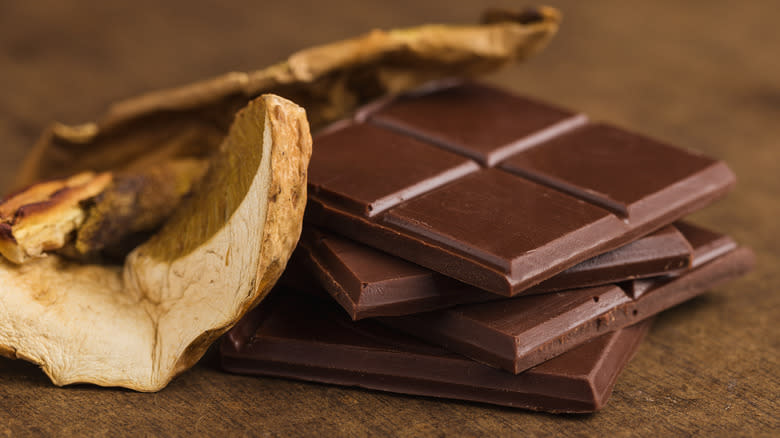What Is Mushroom Chocolate Actually Made Of?

The year is 2024 and, in addition to the best hors d'oeuvres to impress at dinner parties, cookbooks have been published on the subject of crafting Michelin-grade edibles. Foodies can dive into countless culinary compendiums for making THC-infused brownies that don't taste like skunk spray and would give your local bakery a run for its money. The intersection of food and ingestible substances is becoming more delicious by the day, and as that space expands, so do the substances to which it applies. Enter: Mushroom chocolate.
To be clear, when we say "mushroom chocolate," we aren't talking about mushroom-adaptogen-infused wellness products like the "chagaccino" latte that went viral last year. We're talking about chocolate bars that have been infused with psilocybin, the active hallucinogenic ingredient in mushrooms, aka "shrooms."
Folks know a lot about what mushroom chocolate can do, but they seem to know less about what mushroom chocolate actually is. Ultimately, in the same way that "weed brownies" tote a self-explanatory moniker, "mushroom chocolate" is just a combination of its eponymous ingredients, mushrooms and chocolate. The entheogenic mushrooms must be powdered, dried, and finely minced, or concentrated into a liquid tincture, but beyond that, they're simply stirred into regular chocolate, melted in a double boiler or saucepan, measured with a candy thermometer, and poured into a mold to shape -- just as you might make homemade chocolates.
Read more: 25 Chocolate Brands, Ranked Worst To Best
Variations Of A Psychedelic Treat

Processing mushrooms into chocolate bypasses the notoriously earthy taste and spongy texture (a sensation that is unpleasant to many). While all it requires is meltable chocolate and entheogenic mushrooms, any other flavorful ingredients you might add can be welcome cosmetic additions. Iconic hallucinogenic pioneer outlet Double Blind Magazine shares a recipe for mushroom chocolate -- a straightforward yet decadent combination of cacao powder, cacao butter, maple syrup, mushroom tincture, vanilla extract, cinnamon, cayenne pepper, and salt.
Mushroom chocolate isn't just for experienced psychedelic users either, as consumers can opt to break as many squares off of the bar as they please per serving. Stem's Milky Way Mushroom Bar, for instance, contains 6 grams of psilocybin total, with each square containing 1 gram. A recreational dose of mushrooms is around 2 to 3 grams. Microdosing refers to taking 5% to 10% of a recreational dose, roughly 0.1 to 0.5 grams depending on individual preference.
Online retailers like Stem carry a variety of vegan options, and PolkaDot (another prominent brand) carries a wide range of gourmet offerings from Belgian chocolate truffles to flavors like matcha and pistachio. Beyond a fun, playful treat in chocolate form, Healthline states that research has shown psilocybin's potential for medical treatment for conditions including depression, obsessive-compulsive disorder, and alcoholism. Many have even turned to mushroom chocolate as an alternative to drinking.
Read the original article on Tasting Table.

